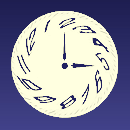

Disclaimer: I am not a medical doctor. These are my personal opinions. The listed references bear on my thoughts, but do not necessarily draw the same conclusions. You should not use the information on this web page for diagnosing or treating a medical or health condition on your own. All decisions regarding patient care should be made with your healthcare provider.
Many people respond to treatment. Nevertheless,
I have read the personal stories of many people with DSPS or Non-24 who have tried, for long periods of time and at great personal distress, to follow their doctor's treatment prescriptions, but the treatment failed. It failed in that the patients complained of increasing tiredness, decreasing ability to function normally in their lives, even illness. In less severe cases, the reports were of lack of alertness, memory difficulties, or feelings of being dissociated from life. Reference [1] (below) provides numerical estimates of success rates that support this observation: 42% for DSPS, 32% for Non-24. Clearly success rates will vary considerably depending on the details of the interventions.
Most studies of the effects of light on circadian rhythms have been performed on subjects with normal circadian rhythms. The effects could be quite different for someone whose response to light is less than, or greater than, normal. In particular, Phase-Response Curves (PRCs) for light and for melatonin have been developed from studies on normal sleepers [2,3]. But the data from normals are used for treating DSPS patients and even Non-24 patients, for determining the best time to apply light therapy and the amount and timing of melatonin administration. The data may not carry over for these patients.
Nevertheless, because of the variability in the responses of people with circadian disorders it is often difficult to obtain and to interpret analogous data for these patients. So it makes sense to use the PRCs developed for normal sleepers as a starting point. The sleep doctor can then continue to monitor the patient and adjust the treatment according to individual response.
In some cases, research on shift work disorder in otherwise normal sleepers is used to treat DSPS patients [4], some of whom may have underlying impairments that make the research results inapplicable.
There are likely several different things that can cause Circadian Rhythm Sleep Disorders (CRSDs). These probably include lack of sensitivity to light, over-sensitivity to light [14], deficiencies in the ipRGCs (instrinsically photosensitive Retinal Ganglion Cells) of the retina, lack of melatonin production, long elimination time of melatonin, long intrinsic circadian period, differences in timing of sleep relative to internal circadian rhythms, differences in tolerance to phase mismatch, etc [5].
The studies of treatments done to date do not distinguish between the various causes. So the conclusions may or may not apply to you, depending on your specific cause of CRSD.
I would conjecture, for example, that for people who are not sensitive enough to light, very bright light in the morning is what works. For those
super-sensitive to light, light restriction in the evening (sometimes called "dark therapy") is key.
Added Dec 2013: The new DSM-5 [13] says:
Most treatment studies measure Dim Light Melatonin Onset (DLMO) and/or core body temperature (CBT). There are other body rhythms, including alertness, digestion, cortisol, thyroid, libido, etc. Perhaps they don't all shift in sync [6,7] - in jet lag, for a related example, it is believed that the various rhythms get out of sync [8].
Different people can respond very differently. For example, one study administered the same dose of melatonin to different individuals and found 35-fold variation in plasma concentration [9]. Another study found 25-fold variation [10]. So the same dose of melatonin may have very different effects on different patients.
Most studies of interventions for CRSDs are completed in a matter of weeks, and report on success or failure in shifting the subjects' schedules. But in practical terms, a treatment is successful only if the patient continues to be able to follow the prescribed schedule. This is not always the case [11].
Many research studies which conclude that the patients have reset their clocks measure DLMO and/or CBT, but don't measure sleep quality, daytime performance, or subjective well-being [12]. Even polysomnograph data doesn't correlate well with subjective sleep quality [15].
Some patients complain that they still don't feel rested after sleeping on the new schedule after treatment.
For this reason they may choose not to continue treatment, so the "low compliance" often cited in the literature may be due to this lack of subjective improvement.
These references influenced the thought processes which led to my conclusions. They do not necessarily draw the same conclusions.
Much Research Is Done on Normal Sleepers
Multiple Causes of CRSDs
Predisposing factors may include a longer than average circadian period, changes in light sensitivity, and impaired homeostatic sleep drive. Some individuals with delayed sleep phase type may be hypersensitive to evening light, which can serve as a delay signal to the circadian clock, or they may be hyposensitive to morning light such that its phase-advancing effects are reduced.
Multiple Rhythms Not in Sync
Melatonin: Differences Between Individuals
Short Term vs Long Term Success
Does the Treatment Really Fix Your Sleep?
References